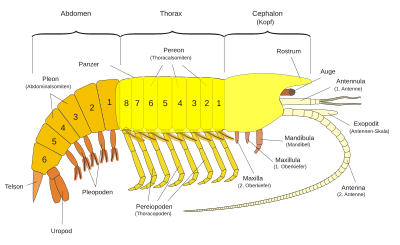Pleon (crabs)
The pleon is the forwards and backwards movable rear part of the body (or tagma ) in the higher crabs ( class Malacostraca). Usually, although anatomically controversial, it is equated with the abdomen .

The pleon consists of two parts. The larger part adjoining the front trunk section or pereion with the pairs of legs (and possibly the scissors ) consists of six leg- bearing segments, the pleomers. This is followed by the non-segmental, limb-free telson with the anus opening (articulated appendages of the telson itself, known as furca, never occur in the Malacostraca, unlike other crustaceans). Only in the Phyllocarida (with the only recent order Leptostraca ) is a limbless, seventh pleomer inserted in between, so they have one more visible segment than the Eumalacostraca. The limbs of the pleomeres are called pleopods , the sixth and last pair, which are always shaped differently from the others, are called uropods .
Traditionally, the border between the thorax and the abdomen in cancers is defined by the position of the gonopores . So the pleon would be a real abdomen.
By examining the expression of Hox genes but could probably be made that the Pleomere, not the abdominal segments of insects, or those of other crustaceans homologous are. The pleon and pereion essentially represent two mutually differentiated trunk sections. Possibly the seventh pleomer of the Phyllocarida as a rudiment is homologous to the abdomen of the other crustaceans.
The large pleon muscle of the higher crustaceans allows a jerky contraction, which catapults the animal backwards very quickly, especially in species with a large tail fan. This muscle forms the commercially traded crab meat, for example the " North Sea crab ".
Individual evidence
- ^ Crustacea Glossary, Natural History Museum of Los Angeles County
- ↑ Verena Kutschera, Andreas Maas, Dieter Waloszek: Uropods of Eumalacostraca (Crustacea sl: Malacostraca) and their phylogenetic significance. In: Arthropod Systematics & Phylogeny. 70 (3), 2012, pp. 181-206.
- ↑ Arhat Abzhanov, Thomas C. Kaufman: Crustacean (malacostracan) Hox genes and the evolution of the arthropod trunk. In: Development. 127, 2000, pp. 2239-2249.
- ↑ KE Lauterbach: About the origin of the Malacostraca (Crustacea). In: Zoologischer Anzeiger. 194, 1975, pp. 165-179.
- ^ S. Richter, G. Scholtz: Phylogenetic analysis of the Malacostraca (Crustacea). In: Journal of Zoological Systematics and Evolutionary Research. 39, 2001, pp. 113-136.
swell
- Gerhard Scholtz: Evolutionary Developmental Biology of Crustacea . (= Crustacean Issues 15). AA Balkema (Taylor & Francis), Lisse 2004, ISBN 90-5809-637-8 .